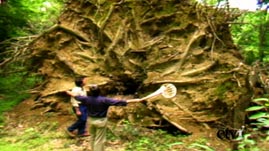Teachers' Domain - Digital Media for the Classroom and Professional Development
User: Preview

Source: NatureScene: “The Congaree Swamp”
In this video segment from NatureScene, learn about the structural adaptations of trees like the cypress and tupelo to the floodplain environment in the Congaree Swamp. These adaptations, such as modified roots, swollen bases, and shallow root systems, allow them to deal with lack of oxygen and flooding for prolonged periods.
Adaptations of tree roots and bases at Congaree Swamp allow trees to survive in the floodplain ecosystem despite frequent flood events and waterlogged soils. Many trees at the swamp are hydrophytes or water plants, species that exhibit morphological adaptations to situations where their roots are continuously submerged in water. These changes are structural adaptations rather than reproductive or physiological adaptations.
Two signature trees at the Congaree Swamp, both well suited to the continuously flooded environments, are the bald cypress and water tupelo. The fluted base of the bald cypress and the swollen base of the water tupelo provide added structural support and better weight distribution for their shallow root systems.
Additionally, cypress roots, like roots of mangrove trees, are often above ground, with multiple stems branching like arms from the bases, extending outward and away to gain a stronghold. Roots like these that form in unusual places, such as from shoot tissue, are called adventitious. The modified roots or “knees” of the bald cypress extend from the root systems to above the standard water level. Cypress knees may also act as aerial roots that assist with exchange of carbon dioxide and oxygen, although this has not been confirmed scientifically.
As evident in trees that have been toppled by wind, shallow root systems are common to trees in floodplain environments, where below-ground saturation and lack of oxygen prevent any root from growing very deeply. While the deepest roots might be found on trees in a desert environment, roots in a floodplain grow out laterally on all sides, and closer to the soil surface to receive oxygen more easily. Shallow root systems also enable trees to take up phosphorous more easily from soil sediment and leaf litter as part of nutrient cycling.
To learn more about the Congaree Swamp, check out Flood Plain and Higher Ground Habitats, Diversity of Hardwoods at Congaree Swamp, Reptiles of the Congaree Swamp, and Primitive Insects of the Congaree Swamp.
To see examples of other kinds of wetlands, check out An Everglades Visit, The Value of Wetlands, and Hurricane Katrina: Wetland Destruction.
 Loading Standards
Loading Standards